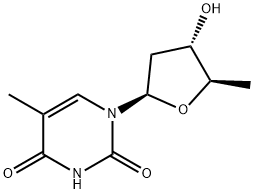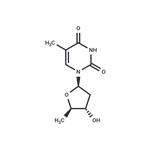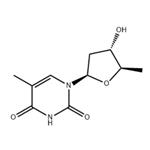Uses
The pyrimidine thymidine consists of thymine combined with deoxyribose. Prior to polymerization into DNA, thymidine must be phosphorylated at the hydroxyl group on carbon 5 of the ribose moiety. 5'-Deoxythymidine is a form of thymidine in which the hydroxyl group on carbon 5 of ribose has been replaced with hydrogen. As a result, this compound cannot be phosphorylated and used by DNA polymerase in the synthesis of DNA. 5'-Deoxythymidine is readily imported by cellular nucleoside importers and competitively inhibits the influx of thymidine. It demonstrates antibacterial activity against B. subtilis and S. aureus.[Cayman Chemical]
Biological Activity
5'-deoxy thymidine has been used as a research tool for antiviral and anticancer studies. 5'-deoxy thymidine can be used to study the entry mechanism into human erythrocytes in comparison with other deoxythymidines. deoxythymidine, also named as thymidine, is the dna nucleoside t. deoxythymidine can pair with deoxyadenosine (a) in double-stranded dna. 5'-deoxy thymidine is a form of thymidine which had the hydroxyl group at the 5' position replaced with hydrogen [1]. 5'-deoxy thymidine (50 μg/ml) was effective against bacillus subtilis and staphylococcus aureus [1]. the mbc of 5'-deoxy thymidine was 50 μg/ml. 5'-deoxy thymidine has been used as an antibacterial agent in medical situations [1].thymidine has been phosphorylated at the hydroxyl group on carbon 5 of the ribose moiety before polymerization into dna. 5'-deoxy thymidine cannot be phosphorylated and used by dna polymerase in the synthesis of dna. in human erythrocytes, 5'-deoxy thymidine was readily and nonconcentratively uptaked by metabolism, and could be partially inhibited by nucleosides or inhibitors of nucleoside transport at micromolar concentrations [2].
References
[1] hatano a, nishimura m, souta i. impact of unnatural nucleosides on the control of microbial growth[j]. biocontrol science, 2009, 14(2): 55-60.
[2] domin b a, mahony w b, koszalka g w, et al. membrane permeation characteristics of 5'-modified thymidine analogs[j]. molecular pharmacology, 1992, 41(5): 950-956.


